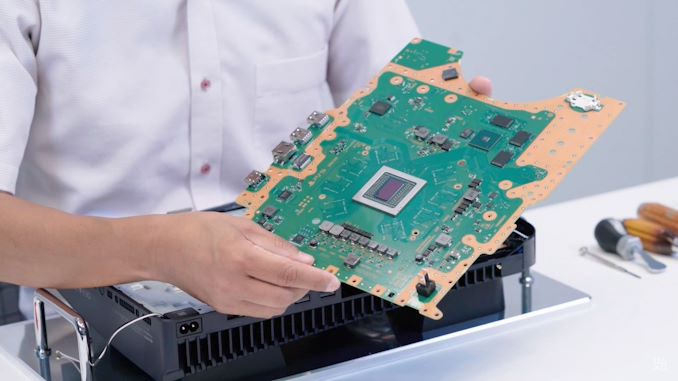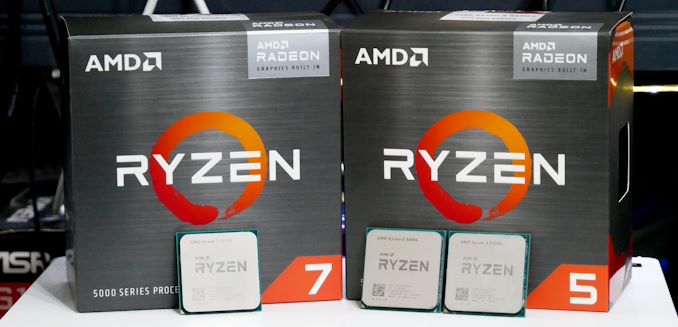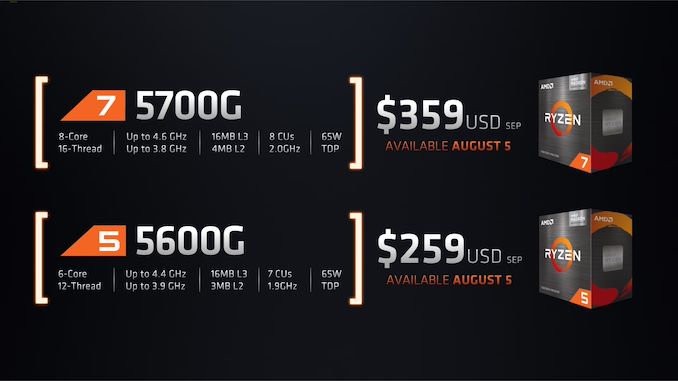The AMD Ryzen 7 5700G, Ryzen 5 5600G, and Ryzen 3 5300G Review
by Dr. Ian Cutress on August 4, 2021 1:45 PM ESTA Great Alternative to Regular Ryzen
I’m a big fan of a cheap and efficient solution for a PC that performs well and just works. Sometimes when building these systems, the fewer parts the better, as it means less can go wrong, but there is also a desire to ensure the system will last and remain fast during its tenure.
Historically a processor with integrated graphics fit the bill. They used to be a dime a dozen (or up to $150), and when paired with a good small motherboard and a couple of memory modules, an SSD, and a good stock cooler, then someone like my father can browse the web and do office stuff on his 32-inch display and join the weekly family zoom call without having to sit there for the system to respond.
What AMD has here with the new Ryzen 5000G desktop APUs is something that fast. Equipping up to eight Zen 3 cores around 4.0 GHz in a system should cater to almost* everyone’s compute needs. The new 5000G APUs are generationally a really nice improvement in raw compute performance over 4000G, but because 4000G wasn’t really at retail, we’re looking at 3000G, and the new hardware wipes the floor here. The only downside is that AMD didn’t release the cheapest offering.
Only the Ryzen 7 5700G ($359) and Ryzen 5 5600G ($259) are coming to market. Both of these processors are around about the same performance as their desktop variants (5800X and 5600X), so it probably won’t be much of a surprise to see these parts in our CPU guides going forward where we would normally recommend the X processors. The problem with these though is that the 5300G isn’t coming to market, at something like $159.
The Ryzen 3 5300G has been a fun processor to test. In every test it surpasses the previous retail APU flagship (the R5 3400G), and even if we compare it to the OEM flagship the R7 4750G, in a few tests it beats it there as well, both in regular performance and in gaming.
So why isn’t AMD selling the Ryzen 3 5300G at retail? Perhaps because it doesn’t need to. Demand for AMD’s regular processor lineup has been strong, and it is only recently where we’re seeing processors like the 5600X and 5800X come back down to MSRP and in stock regularly. AMD makes more profit on those processors (probably), so it would rather sell those. By keeping the 5300G behind, it drives users up to the mid and high-tier 5000G parts, increasing the average selling price and revenue. And in a market where all silicon seems to be being sold, it’s a clever productization tactic. The 5300G at a $159 price point would have a special place in many builds. Until that time, users will have to make do with a 5600G.
The Ryzen 7 5700G and Ryzen 5 5600G go on sale tomorrow, on August 5th 2021.
Do APUs Make Sense For Gaming Yet?
Ever since graphics hardware has been attached to CPU cores, we’ve always wondered: ‘At what point can it be powerful enough to consume the entry-level market?’. Theoretically, year on year, the graphics capabilities of what is in the silicon has improved, and we get speed increases in the same way we see CPU core performance increases. However it is not always the silicon that matters.
Games are also getting more complex. In the same way that every year we get more performance, every year the required specifications for modern games go up. Developers get ambitious, and they want to convert their artistic vision onto a system, and there are often two main targets for those developments: playable on consoles, and the best experience on a super expensive PC. This creates a problem for the lowly integrated graphics solution, because they end up powered well below that of consoles.

A PS5 Processor with Integrated Graphics
Consoles have the added benefit of being a hyper-optimized and well-defined platform: the software stack is built on gaming performance and developers can cater to it. Because integrated graphics can come in many different shapes and colors, we’re relying on some of those optimizations to filter down. Not only that but new technologies such as AMD’s Fidelity SuperFX Resolution are aimed at getting a better experience with less compute power. While game requirements are getting higher, at least the tricks to get better performance are also coming along.
So why not build a big integrated graphics solution for desktops, like a console? First is the market optics – realistically AMD is the main vendor in the console game but also the only vendor taking integrated graphics solutions seriously, so there’s no desire to cross-contaminate each market segment. Second is the market size – a discrete GPU, even one at 75 W, doesn’t have to compete with a joint power budget with a CPU, whereas an integrated solution does, and how many users really want a joint power budget for a main gaming system? One could easily argue that APUs make sense for those on a budget, or someone looking for a smaller system without a discrete card, and not a lot else.
On a budget, you could easily build a Ryzen 5 5600G gaming system with good recommended components for $621, providing you with almost the best integrated gaming experience while at the same time performing near-the-same or beating last generation’s flagship APU in day-to-day tasks. Moving up to Zen 3 with a larger L3 cache has really unlocked more of the performance in these cores and in the graphics.
One of the big questions on the horizon is regarding how AMD might use its 3D V-Cache technology in the future. The current implementation is a 64 MB die that sits on top of the cache in a regular CPU chiplet. That same chiplet won’t work on an APU, but AMD could very much design one in a similar fashion for its integrated graphics – perhaps adding another 32 MB of L3 cache. The question on that then becomes how much extra will it cost, and whether the trade-off is worth it. At a time where discrete graphics solutions are still crazy expensive, it is perhaps not as farfetched as you might think. However, based on AMD’s disclosures, don’t expect a chip like this anytime soon.












135 Comments
View All Comments
Wereweeb - Wednesday, August 4, 2021 - link
The bottleneck is memory bandwidth. DDR5 will raise the iGPU performance roof by a substantial amount, but I hope for something like quad-channel OMI-esque Serial RAM.abufrejoval - Saturday, August 7, 2021 - link
I'd say so, too, but...I have just had a look at a Kaveri A10-7850K with DDR3-2400 (100 Watt desktop), a 5800U based notebook with LPDDR4 (1333MHz clock) and a Tiger Lake NUC with an i7-1165G7 with DDR4-3200.
The memory bandwidth differences between the Kaveri and the 5800U is absolutely minor, 38.4 GB/s for the Kaveri vs. 42.7GB/s for Cezanne (can't get the TigerLake figures right now, because it's running a Linux server, but it will be very similar).
The Kaveri and Cezanne iGPUs are both 512 shaders and apart from architectural improvements very much differ in clocks 720MHz vs. 2000MHz. The graphics performance difference on things like 3DMark scale pretty exactly with that clock difference.
Yet when Kaveri was launched, Anandtech noted that the 512 shader A10 variant had trouble to do better then the 384 shader APUs, because only with the very fastest RAM it could make these extra shaders pump out extra FPS.
When I compared the Cezanne iGPU against the TigerLake X2, both systems at tightly fixed 15 and 28Watts max power settings, TigerLake was around 50% faster on all synthetic GPU benchmarks.
The only explanation I have for these fantastic performance increases is much larger caches being very smartly used by breaking down GPU workloads to just fit within them, while prefetching the next tile of bitmaps into the cache in the background and likewise pushing processed tiles to the framebuffer RAM asynchronously to avoid stalling GPU pipelines.
And yet I'd agree that there really isn't much wiggling room left, you need exponential bandwidth to cover square resolution increases.
abufrejoval - Saturday, August 7, 2021 - link
need edit!Is TigerLake Xe, not X2.
Another data point:
I also have an NUC8 with an 48EU (+128MB eDRAM) Iris 655 i7 and a NUC10 with an 24EU "no Iris" UHD i7. Even with twice the EUs and the extra eDRAM (which I believe can be used in parallel to the external DRAM), the Iris only gets a 50% performance increase.
The the 96EU TigerLake iGPU is doing so much better (better than linear scale over UHD) while it actually has somewhat less bandwidth (and higher latency) than the 50GB/s eDRAM provides for the 48EU Iris.
bwj - Wednesday, August 4, 2021 - link
Why are these parts getting stomped by Intel and their non-graphics Ryzen siblings?bwj - Wednesday, August 4, 2021 - link
Meh, meant to say "in browser benchmarks". Browser is an important workload (for me at least) and the x86 crowd is already fairly weak versus Apple M1, so I'm not ready to throw away another 30% of browser perf.Lezmaka - Wednesday, August 4, 2021 - link
There are only 3 browser tests and for two of them the 5700G is within a few percent of the 11700K. But otherwise, it's because these are laptop chips with higher TDP. The 11700K has a TDP of "125W" but hit 277W where the 5700G has a TDP of 65W and maxed out at 88W.Makaveli - Wednesday, August 4, 2021 - link
There is something up with the browser scores here anyways compared to what you see in the forum. All the post with similar desktop cpu's in that thread post much high scores than what is listed in the graph. I'm not sure its old browser version being used to keep scores inline with older reviews or something.https://forums.anandtech.com/threads/how-fast-is-y...
abufrejoval - Wednesday, August 4, 2021 - link
When you ask: "Why don't they release the four core variant?" you really should be able to answer that yourself!There are simply not enough defective chips to make it viable just yet. Eventually they may accumulate, but as long as they are trying to produce an 8 core chip, 4 and 6 cores should remain the exception not the rule.
I'd really like to see them struggle putting the lesser chips out there, because it means my 8/16(/32/64) core chips are rock solid!
I would have liked to see full transistor counts of the 5800X and the 5700U side by side. My guess would be that the Cezanne dies even at 50% cache have more transistors overall, meaning you are getting many more pricey 7nm transistors per € on these APUs and should really pay a markup not a discount.
Well even the GF IO die fab capacity might have customers lined up these days, but in normal times those transistors should be much more commodity and cheaper and have the APU cost more in pure foundry (less in packaging) than the X-variants, while AMD wants to fit it into a below premium price slot where it really doesn't belong.
nandnandnand - Wednesday, August 4, 2021 - link
If AMD boosted chiplet/monolithic core count to 12, maybe 6 cores could become the new minimum with 10-core being a possibility. But it doesn't look like they plan to do that.Wereweeb - Wednesday, August 4, 2021 - link
These might have been a stockpile of dies that were rejected for laptop use (High power consumption @ idle?) and they're being dumped into the market after AMD satisfied OEM demand for APU's.Plus, considering that one of the main shortages is for substrates, it's possible that the substrate for the APU's is different - cheaper, higher volume, etc... as it doesn't need to interconnect discrete chiplets.